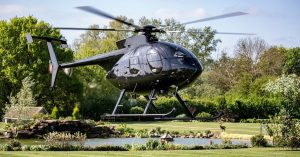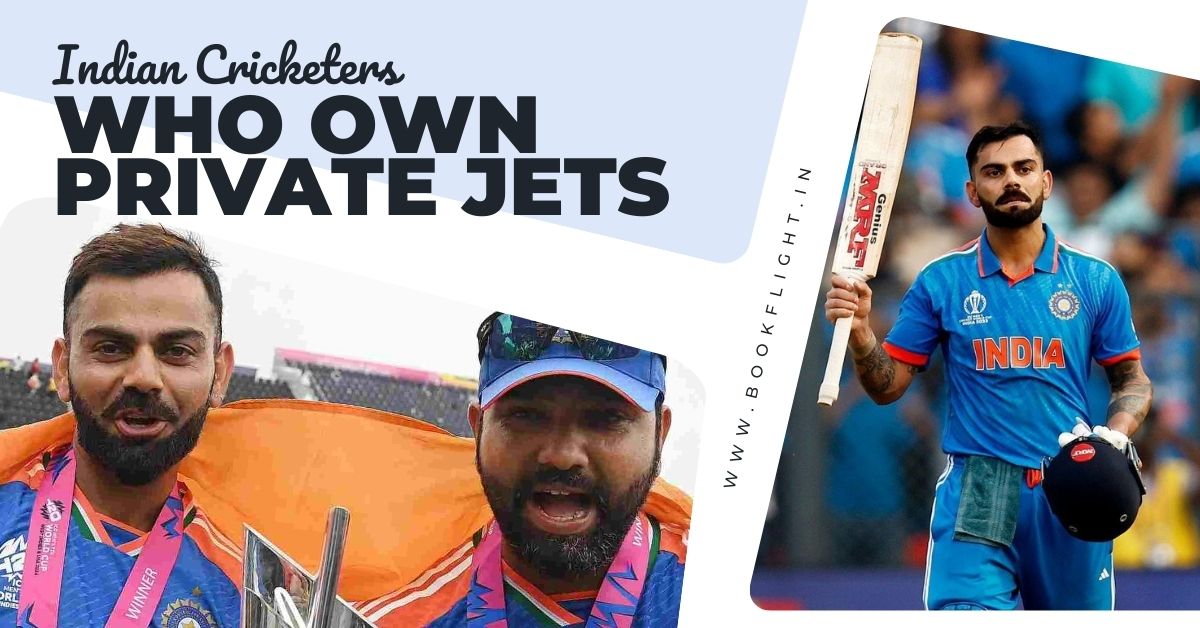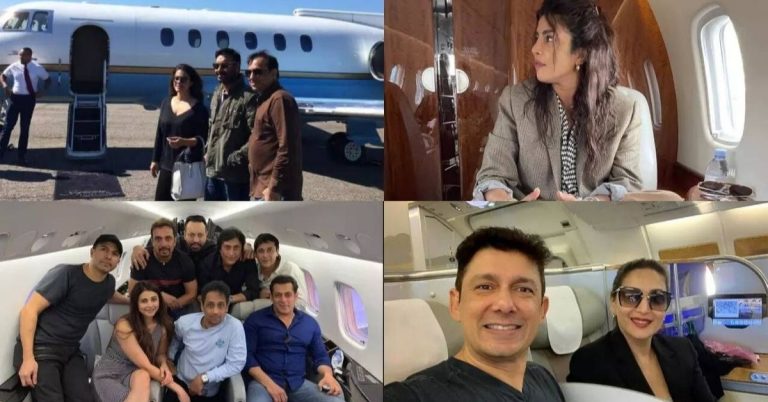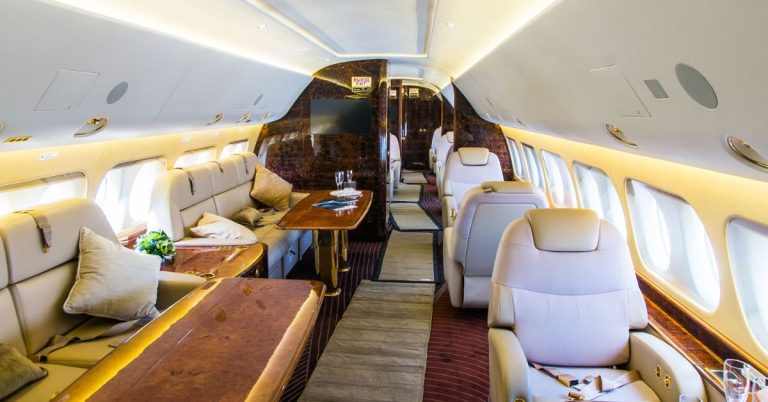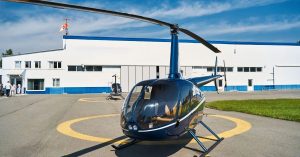In the high-octane world of professional sports, time is not just money — it’s performance, prestige, and peace of mind. And no one knows this better than Indian cricketers who own private jets. These modern-day cricketing legends live lives that oscillate between international stadiums, luxury brand endorsements, and whirlwind tours. Amid such relentless schedules, the ability to fly on one’s own terms isn’t just a status symbol — it’s a strategic advantage.
Welcome to the exclusive airspace of Indian cricketers who own private jets — a club where elite players trade boarding passes for personalized flight paths, and the economy-class rush for executive lounges in the sky. From Virat Kohli’s sleek lifestyle to MS Dhoni’s aviation dreams, these cricketers have taken their game quite literally to another level — above the clouds.
This isn’t just about flamboyance. It’s about comfort, recovery, and maximizing efficiency in a sport where every ounce of energy counts. Owning a private jet is a decision influenced by personal values, performance demands, and an undeniable touch of style.
In this article, we’ll explore the stories, the aircraft, the costs, and the reasons why more Indian cricketers are choosing to soar privately. Whether you’re a cricket lover, an aviation enthusiast, or simply curious about the lifestyles of sports megastars — buckle up. You’re about to take a journey inside the cabins, minds, and mile-high ambitions of Indian cricketers who own private jets.
Indian Cricketers Who Own Private Jets
In a country where cricket is worshipped and cricketers are revered as gods, it’s no surprise that some of the biggest names in Indian cricket have extended their dominion into the skies. Yes, we’re talking about Indian cricketers who own private jets — a fascinating blend of athletic success, global fame, and elevated lifestyle.
Private jet ownership among Indian cricketers isn’t just about flaunting wealth. It’s a calculated investment in time management, privacy, and peak performance. In this section, we take a closer look at the cricketing elites who fly high — both in their careers and in altitude.
Virat Kohli – The Jet-Set Icon
When it comes to Indian cricketers who own private jets, Virat Kohli leads the conversation. With a brand value exceeding ₹1,000 crores and an intense travel schedule, Kohli has all the reasons to rely on private aviation.
Though official ownership hasn’t been publicly confirmed, he is often seen flying in premium jets like the Cessna Citation XLS+ or Bombardier Challenger 350, either through long-term charters or fractional programs.
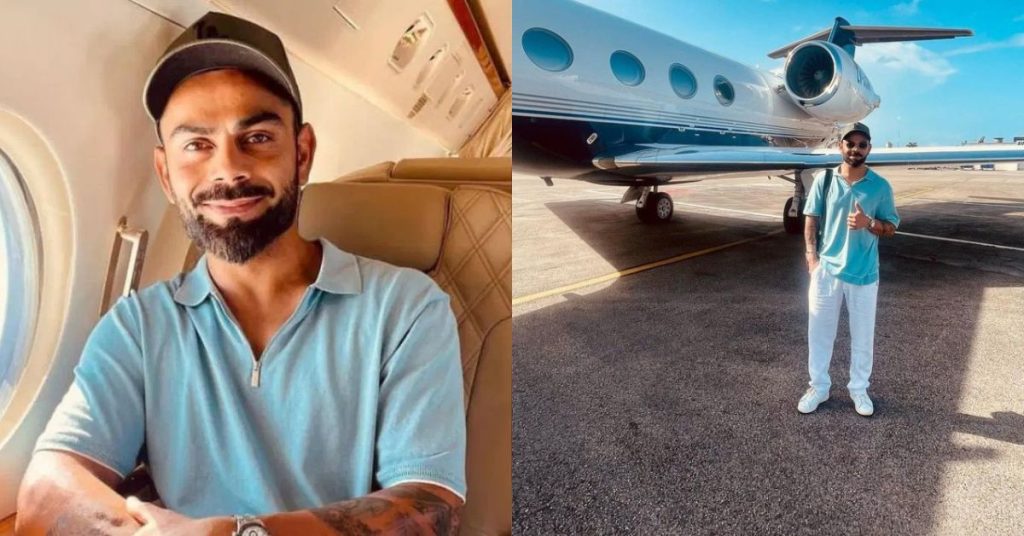
Virat Kohli’s lifestyle demands mobility, comfort, and efficiency — everything a private jet delivers.
These jets feature:
- Quiet cabins perfect for rest and recovery
- Room for 8–10 passengers
- Flight range of 3,200+ km — ideal for hopping between IPL cities or flying to Dubai overnight
- Onboard Wi-Fi, recliner leather seating, and gourmet catering
With these capabilities, Kohli escapes long airport lines and recovers in the air — maintaining peak focus and fitness wherever he goes.
MS Dhoni – The Sky Captain
Mahendra Singh Dhoni, fondly called “Captain Cool,” is one of the few Indian cricketers who own private jets with a genuine passion for aviation. A licensed pilot himself, Dhoni’s love for flying is as well-documented as his helicopter shot.
Dhoni reportedly owns a Cessna Citation 560XL, a mid-size jet popular for domestic routes and short international hops. With a cruising speed of 800 km/h and a range of around 3,800 km, this aircraft suits Dhoni’s travel needs perfectly — whether it’s from Ranchi to Chennai or Mumbai to Delhi. Want more on jet speed? Here’s a breakdown of how fast private jets really fly.
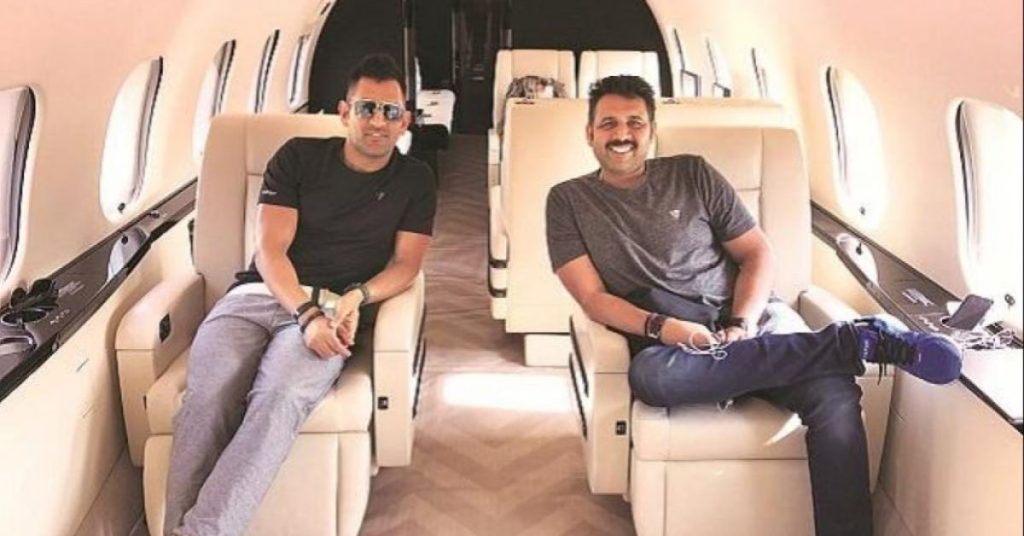
MS Dhoni is not just a cricketer who flies — he’s a cricketer who flies the plane.
Used often during IPL seasons, Dhoni’s private jet allows him to travel swiftly between matches, team camps, and commercial events while avoiding public exposure and travel fatigue.
Sachin Tendulkar – The God of Cricket and Comfort
Sachin Tendulkar, the original icon of modern Indian cricket, may not publicly flaunt private jet ownership, but he has frequently been spotted boarding luxurious charter jets for domestic and international events.
As one of the first Indian cricketers who own or extensively use private jets, Tendulkar often flies in aircraft like the Dassault Falcon 2000 — a twin-engine business jet with a plush cabin and a range exceeding 6,000 km.
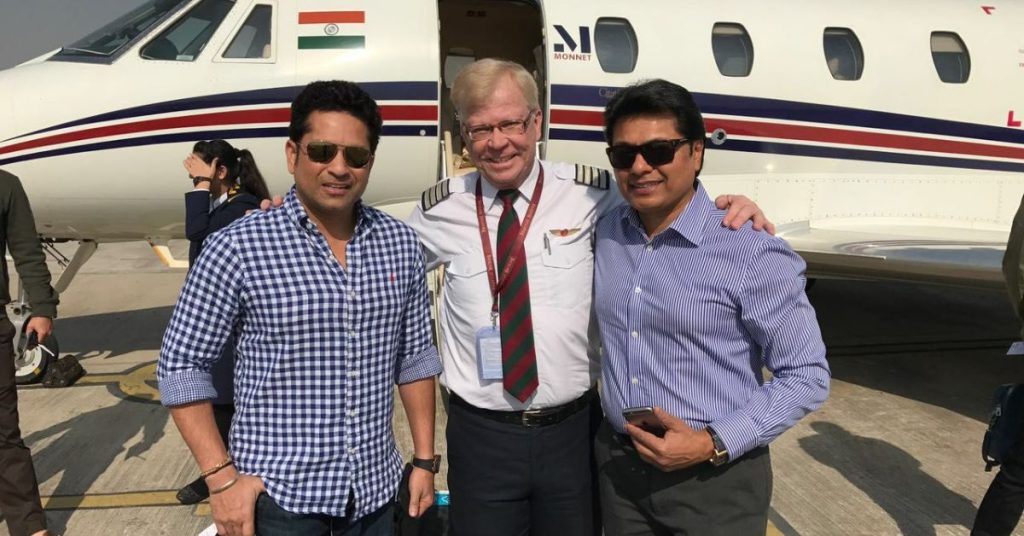
For Sachin, comfort and precision matter as much in the air as on the pitch.
Whether attending events in London, flying for philanthropic causes, or making swift business trips, private aviation helps Tendulkar retain his privacy and composure — qualities that defined his game.
Hardik Pandya – The Flair in the Air
If there’s one modern player who embodies glamour, it’s Hardik Pandya. Known for his luxurious lifestyle, he has been seen jetting across India and abroad in private aircraft — often sharing his journeys on social media.
While official records of ownership remain speculative, Pandya’s frequent use of jets like the Hawker 400XP or Learjet 75 places him among Indian cricketers who fly private jets regularly, if not own them outright.

Hardik’s jet-setting lifestyle reflects the modern cricketer’s need for fast, stylish, and private travel.
These light jets are perfect for shorter Indian routes — such as Mumbai to Bangalore — offering both speed and visual appeal. In the influencer-driven world of today’s cricket, private jets aren’t just transport — they’re part of the brand.
Kapil Dev and Cricket Legends of Yesteryears
Kapil Dev, India’s 1983 World Cup-winning captain, may not be actively flying for cricket today, but he has often utilized private aviation for commentary gigs, appearances, and golf outings. While full ownership remains unverified, Kapil and other senior cricketers frequently fly private — sometimes as co-investors in jet partnerships.
Former cricketers, especially those in business or media roles, prefer aircraft like the Embraer Phenom 300 or Pilatus PC-24 for their range, affordability, and comfort.
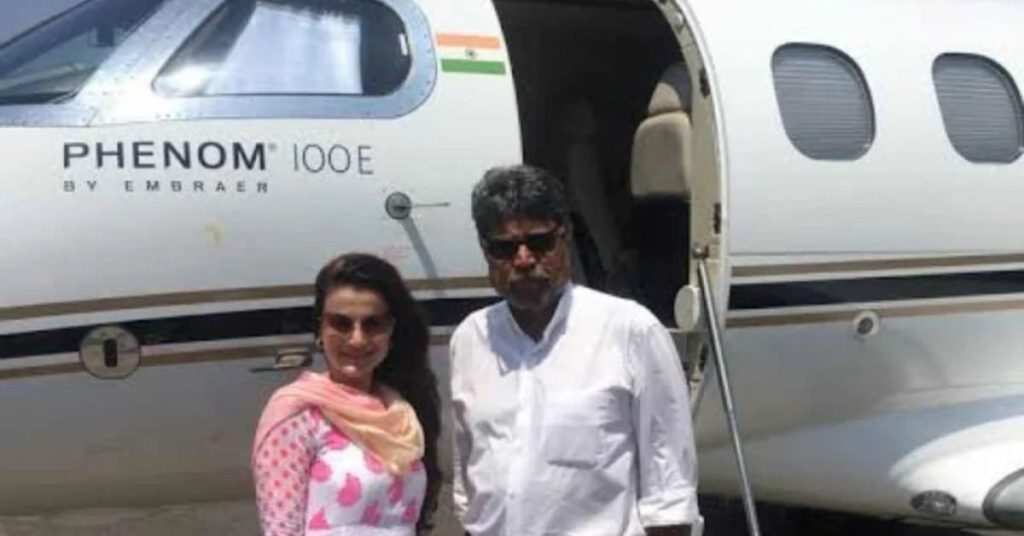
For legends like Kapil Dev, private flying is about legacy, comfort, and lifestyle continuity.
This evolution shows how even retired stars stay connected to private aviation — for leisure, business, or legacy travel.
Quick Summary Table: Indian Cricketers and Their Jets
| Cricketer | Jet Model | Estimated Cost | Usage Type |
|---|---|---|---|
| Virat Kohli | Bombardier Challenger 350 | ₹90–100 crores | Long-term charter/fractional |
| MS Dhoni | Cessna Citation 560XL | ₹60–70 crores | Owned (reportedly) |
| Sachin Tendulkar | Dassault Falcon 2000 | ₹130–150 crores | Frequent charter |
| Hardik Pandya | Hawker 400XP / Learjet 75 | ₹40–50 crores | Frequent charter |
| Kapil Dev | Phenom 300 / PC-24 | ₹35–45 crores | Event-based flying |
Why Do Indian Cricketers Prefer Private Jets?
In the fast-paced, high-pressure world of modern cricket, travel isn’t just about getting from point A to B — it’s about preserving energy, protecting privacy, and performing at peak. That’s why more and more Indian cricketers who own private jets — or charter them regularly — see them as essential tools rather than indulgent luxuries.
Let’s break down the real reasons behind this growing trend.
1. Time Is Performance
Unlike commercial flights that are bound by schedules and airport wait times, private jets allow Indian cricketers to fly on their own terms. A player like Virat Kohli, who might attend a match, a brand shoot, and a family event across three cities in two days, cannot afford the inefficiencies of commercial travel.
Private aviation eliminates layovers, delayed takeoffs, and long check-ins. They’re also quicker in the sky — but are they actually faster? Find out how private jets compare to commercial jets in speed. With on-demand departure, a cricketer can land just hours before a game — rested, focused, and ready.
2. Privacy and Security
Let’s face it — Indian cricketers are celebrities. They attract crowds, media, and sometimes controversy wherever they go. Private jets offer what airports can’t: complete discretion and personal space.
Whether it’s a sensitive rehab trip, a quiet family getaway, or a business meeting with sponsors, flying private allows cricketers to protect their personal and professional privacy — something invaluable in today’s social media age.
3. Recovery and Rest
Modern jets aren’t just flying machines — they’re wellness sanctuaries. Players often fly post-match with tight turnarounds. Inside a private jet, the quiet cabin, lie-flat seats, controlled lighting, and in-flight meals tailored to their nutrition plan help optimize recovery.
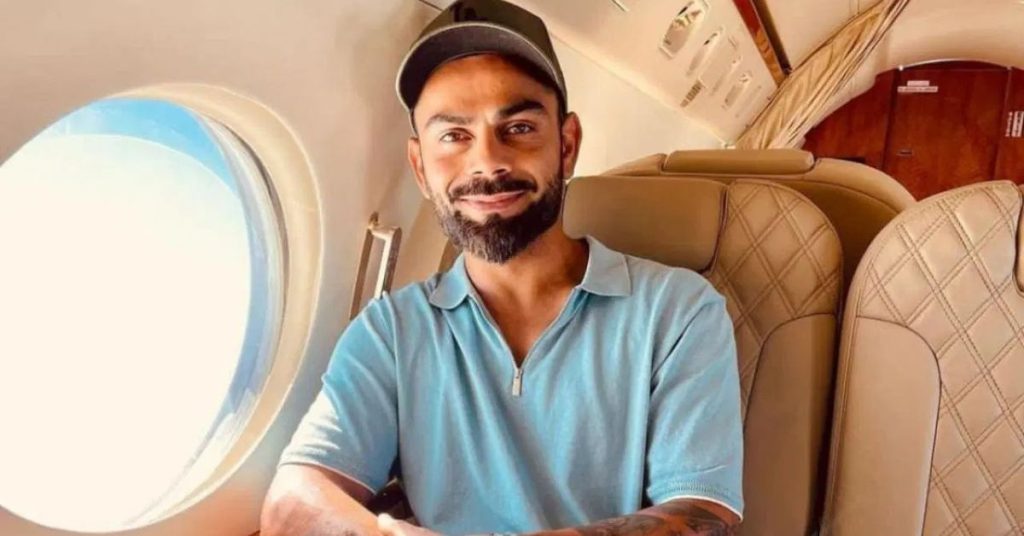
A fatigued player flying commercial is a liability. But a cricketer arriving refreshed from a jet nap could win you the match.
4. Flexibility for Branding and Business
Today’s cricketers are more than athletes — they are brands. With endorsements, product launches, investments, and media appearances becoming part of the job, private aviation allows them to attend multiple high-value engagements in a single day.
For example, Hardik Pandya may shoot an ad in Mumbai at noon, attend a training session in Ahmedabad by 5 PM, and be home in time for dinner — all thanks to a light jet’s flexibility.
5. Strategic Efficiency During IPL and International Tours
During tournaments like the IPL, the logistical pressure is intense. Jet lag, heat, travel — all affect performance. No surprise then that Indian cricketers who own private jets are often those at the top of their game.
Team owners too often arrange charters for marquee players. This isn’t just hospitality — it’s an investment in results.
Aviation Perspective: The ROI of Private Flying
From an aviation professional’s lens, it’s simple: once you hit 200+ flight hours a year, jet ownership or fractional programs start to make financial sense. Cricketers with packed, non-negotiable schedules benefit from block-hour jet cards, managed ownership, or even co-ownership models with team partners or brand collaborators.
Private jets aren’t about being flashy — they’re about being ready. Safety is paramount too. Here’s a breakdown of the safest private jets in the world. And as long as Indian cricket continues to produce world-class athletes with world-spanning careers, the skies will remain a busy place for their private wings.
Private Jets Explained – A Layman’s Guide with Aviation Insights
If you’ve ever wondered what it means when people say a cricketer like Virat Kohli or MS Dhoni flies in a Bombardier or a Cessna, this section will help decode the world of private jets. The aviation industry is filled with models, specs, and categories, but here’s a clear breakdown tailored to how Indian cricketers and other high-net-worth individuals use them.
First, understand that private jets come in different sizes, each suited to a specific mission. The most common types relevant to Indian cricketers who own private jets or fly them frequently are:
Light Jets
These are compact, agile aircraft perfect for short trips within India or to nearby destinations like Dubai, Colombo, or the Maldives. Models like the Hawker 400XP or Learjet 75 seat 6–8 passengers, are fuel-efficient, and can land at smaller airports, offering great convenience during domestic leagues like the IPL.
Mid-Size Jets
Offering more cabin space, longer range, and comfort, mid-size jets like the Cessna Citation XLS+ or Embraer Legacy 450 are a favorite among cricketers who travel for both business and family. These jets are ideal for cross-country routes like Delhi to Kochi or Mumbai to Chennai and typically accommodate 8–10 passengers with extra luggage and standing room.
Heavy Jets / Super-Mid Jets
When cricketers need to travel internationally with entourages, nutritionists, or business teams, heavy jets come into play. Aircraft such as the Bombardier Challenger 350 or Dassault Falcon 2000 offer luxurious amenities like lie-flat beds, conference tables, and multi-zone cabins. With ranges exceeding 5,500 km, they’re suitable for long-haul flights — say, from India to London or Australia. Curious about ultra-long trips? Learn whether a private jet can fly for 12 hours.

Now, let’s clarify a few terms you’ll often hear when discussing the travel habits of Indian cricketers who own private jets:
- Range: The distance a jet can fly non-stop. More range means fewer fuel stops, which matters for international games.
- FBO (Fixed Base Operator): This is a private terminal at an airport. Cricketers bypass the main terminal entirely and check in through an FBO — more secure and time-saving.
- Charter vs. Ownership: Not all cricketers buy jets outright. Many use charter services or block-hour programs, where they pre-purchase flying time and only pay for what they use.
There are also fractional ownership models, where multiple parties co-own a jet and share operating costs. This is common among celebrities, sports stars, and even team owners who don’t need to fly daily but want the benefits of ownership. Curious how billionaires fly? Check out luxury private jets owned by billionaires.
From an industry point of view, cricketers are ideal clients: high-frequency travelers with unpredictable schedules, a need for discretion, and a strong interest in wellness and performance. As a result, aviation companies design offerings specifically around sports personalities — with tailored catering, sports physio space, and even onboard Wi-Fi for media obligations.
Understanding these aircraft categories helps appreciate how and why Indian cricketers who own private jets choose their flying companions. Whether it’s a short-haul trip between IPL matches or a direct route to a global endorsement event, private jets give them the control, comfort, and capability that commercial airlines simply can’t match. Wondering which jets are the most desirable? Here’s a list of the best private jets in the world.
Owning vs Chartering: What Do Cricketers Choose and Why?
Among the growing number of Indian cricketers who own private jets, not all fly the same way. Some prefer full ownership for the autonomy it provides, while others choose flexible charter solutions or jet card programs. Let’s break down how these choices work — and why different players opt for different strategies.
1. Full Ownership: Total Control with Higher Costs
Owning a private jet is the ultimate expression of mobility and prestige. Cricketers like MS Dhoni, who holds a pilot’s license, or Virat Kohli, who frequently flies private, are ideal candidates for jet ownership.
Key benefits of ownership:
- Full control over flight schedules
- Customized interiors and branding (team logos, family crests)
- Ideal for high-frequency flyers (200+ hours per year)
- Immediate availability for last-minute travel
What it costs:
Initial purchase price for a mid-size jet like a Cessna Citation XLS+ or Bombardier Challenger 350 ranges from ₹70 to ₹150 crore. Annual maintenance, crew salaries, hangar fees, insurance, and fuel can cost an additional ₹7–10 crore annually.
Jet ownership is a strong fit for Indian cricketers who own private jets and want total autonomy, exclusive branding, and maximum availability.
2. Chartering: Fly on Demand, Pay-as-You-Go
For cricketers like Hardik Pandya or Shubman Gill, who may not fly as frequently or predictably, chartering makes more sense. With private jet charter services, players can choose different aircraft types for different needs and only pay when they fly.
Advantages of chartering:
- No maintenance or ownership burden
- Choose aircraft based on trip type and group size
- 24/7 service with concierge-level support
- No capital investment required
Estimated cost per hour:
- Light jet: ₹1.5–2 lakh/hour
- Mid-size jet: ₹2.5–3.5 lakh/hour
- Heavy jet: ₹5+ lakh/hour
For many Indian cricketers who use private jets occasionally, this is the smartest entry point into private aviation.
3. Fractional Ownership and Jet Cards: The Middle Path
Some Indian cricketers opt for fractional ownership, where they co-own a jet with a few other individuals or business partners. Others invest in jet card programs, pre-purchasing flight hours at fixed rates.
Why choose these options:
- Lower upfront cost than full ownership
- Priority access to jets during peak travel seasons (like IPL)
- Predictable pricing and simplified planning
- Suits cricketers flying 50–150 hours/year
These programs combine the benefits of private flying with greater cost efficiency, making them increasingly popular among cricketers managing dynamic schedules.
Not every high-flying cricketer needs to buy a jet. While Indian cricketers who own private jets enjoy brand control and constant access, others prefer the agility of chartering or the balance of fractional ownership. The choice comes down to how often they fly, how much flexibility they need, and whether owning the jet outright aligns with their lifestyle and long-term goals.
How Much Does It Cost to Own a Private Jet in India?
For the handful of Indian cricketers who own private jets, the decision is as strategic as it is symbolic. Yes, owning a jet reflects elite status — but behind that elegance lies a complex cost structure. Understanding these costs sheds light on why only a few cricketers own jets outright, while others prefer to charter or co-own.
1. Purchase Cost
Buying a private jet is the biggest upfront investment.
- Light jets (e.g., Learjet 75): ₹35–50 crore
- Mid-size jets (e.g., Cessna Citation XLS+, Embraer Legacy 450): ₹60–90 crore
- Super-midsize/heavy jets (e.g., Bombardier Challenger 350, Dassault Falcon 2000): ₹120–150+ crore
These aircraft are often imported, which means cricketers must also pay custom duties (approx. 18–28%), and comply with DGCA (Directorate General of Civil Aviation) import clearances.
2. Annual Operating Costs
Once purchased, maintaining and flying the jet requires ongoing investment. For Indian cricketers who own private jets, these are some typical recurring costs:
- Fuel: ₹60,000–₹200,000 per hour, depending on jet size and flight length
- Crew salaries: ₹1.5–2 crore annually (for 2 pilots, possibly a cabin attendant)
- Hangar fees: ₹30–60 lakh per year (depending on location and hangar quality)
- Maintenance and parts: ₹2–4 crore/year (routine servicing + unexpected repairs)
- Insurance: ₹25–50 lakh annually (based on aircraft value and coverage)
These expenses add up to an average annual operating cost of ₹7–10 crore or more for a mid-size jet. For cricketers like MS Dhoni or those with steady, year-round commitments, this is a worthwhile investment. But for less frequent flyers, it can become an underutilized asset. Not sure where these jets are stored? Learn more about where people keep their private jets.
3. Compliance and Regulation
All privately operated jets in India are subject to DGCA regulations, including:
- Aircraft registration and airworthiness checks
- Regular crew certifications
- Flight permissions for certain destinations
- Night parking slots at congested airports (like Mumbai or Delhi)
Many jet-owning cricketers work with aviation management companies that handle these compliance issues. These firms charge a management fee (often 5–10% of total operating cost) but provide 24/7 support, scheduling, crew management, and safety compliance.

4. Smart Ownership Strategies
To manage these costs, some Indian cricketers who own private jets structure the purchase under a corporate entity, allowing them to deduct expenses as business costs or lease the aircraft during off-use periods. Others form joint ventures or participate in time-share or fractional ownership models to split the cost and usage with brand partners or team owners. Not just jets — helicopters are also becoming popular among celebrities. Here’s a helpful private helicopter price list in India.
Owning a private jet in India isn’t for everyone — it’s for cricketers with consistent travel demands, brand-building needs, and financial foresight. And when done right, it becomes a power move both on and off the pitch. And if you’ve ever wondered whether older aircraft are still safe to fly, here’s a detailed look at whether a 20-year-old private jet is safe.
What It’s Like Inside a Cricketer’s Private Jet
For most people, flying is a tiring necessity. But for Indian cricketers who own private jets, it’s an extension of their high-performance lifestyle — a sanctuary in the sky. These aircraft aren’t just transport; they’re tailored spaces designed to support elite athletes physically, mentally, and logistically.
1. A Cabin Built for Comfort and Recovery
Step inside a typical private jet used by a cricketer like Virat Kohli or MS Dhoni, and you’ll find an interior designed with wellness in mind. Reclining leather seats, flatbed configurations, noise-insulated cabins, and mood lighting set the tone. Every detail is optimized for rest, hydration, and privacy — especially after a high-intensity game or a long-haul promotional tour.

Depending on the aircraft model, jets are often equipped with:
- Fully flat sleeping berths or recliners with memory foam
- Noise-canceling interiors to reduce fatigue
- In-cabin humidity control to minimize jet lag
- Customized lighting zones for sleep and focus
These features aren’t cosmetic — they’re functional. Cricketers flying long distances need their muscles to recover, their minds to relax, and their bodies to be ready for the next match.
2. Personalized In-Flight Services
Cricketers who fly private enjoy onboard services tailored to their needs. Think curated nutrition-based meals planned by personal chefs, recovery smoothies post-match, and even physiotherapy sessions mid-air.
Top jets used by Indian cricketers who own private jets also come with:
- Secure Wi-Fi for strategic team meetings or sponsor calls
- Screens for game footage review or brand presentations
- Business lounge-style setups to host media teams or family comfortably
This level of personalization is why many players say that flying private doesn’t just save time — it adds value to their preparation.
3. Space for Team, Family, and Staff
Today’s top cricketers don’t travel alone. With managers, physiotherapists, media crews, and sometimes family onboard, the space inside the jet becomes a mobile operations center. A Challenger 350 or Falcon 2000, often used by players or their sponsors, seats up to 10–12 people comfortably, with zones for rest, discussion, and even short recovery stretches.
The ability to travel with your team behind the scenes—coaches, chefs, or PR heads—gives these players a 360-degree edge.
4. Privacy and Mental Focus
Cricketers are public figures, and privacy is not just a luxury — it’s a necessity. Inside their own jet, players can sleep, strategize, or simply disconnect without being watched. This personal space is especially important ahead of major tournaments or emotionally draining tours.
For Indian cricketers who own private jets, flying isn’t downtime — it’s controlled performance space. And in elite sports, that can make all the difference.
Conclusion – More Than a Status Symbol, a Lifestyle Choice
In the glamorous intersection of sports, business, and luxury, Indian cricketers who own private jets represent a new era of elite professionalism. These athletes have transcended boundaries — not just between wickets, but across continents, brands, and personal empires. Some global celebrities even own entire fleets. Discover who owns 10 private jets and how they use them.
From Virat Kohli’s calculated travel strategy to MS Dhoni’s pilot license and hands-on approach, these cricketers are no longer just players — they’re CEOs of their own lifestyle. Private jets support that ambition, offering efficiency, privacy, and health optimization in a world where performance and presence go hand in hand. Jets also serve critical roles beyond luxury — such as emergency medical flights. See the best air ambulance services in India.
But as we’ve seen, ownership isn’t for everyone. Many players wisely choose to charter, co-own, or subscribe to jet card programs. The common denominator? A drive for control over their time, their comfort, and their careers.
For the public, jets may symbolize status. For the cricketer, they symbolize readiness — the ability to rest when needed, appear where expected, and recover without compromise. And that’s what makes the difference between good and great.
As someone who’s spent years in business aviation, I can say this with certainty: Indian cricketers who own private jets are not chasing luxury — they’re investing in longevity, professionalism, and precision. And in the ultra-competitive world of global cricket, that’s just smart strategy.
Now it’s your turn to board the conversation.
If you had a private jet like Kohli or Dhoni, where would you fly first — a match in Melbourne or a beach in the Maldives?
Which cricketer’s jet-set life do you admire most, and why? Drop your dream destination, your thoughts, or even your hot take in the comments below.
Because up here, every opinion flies first class.

